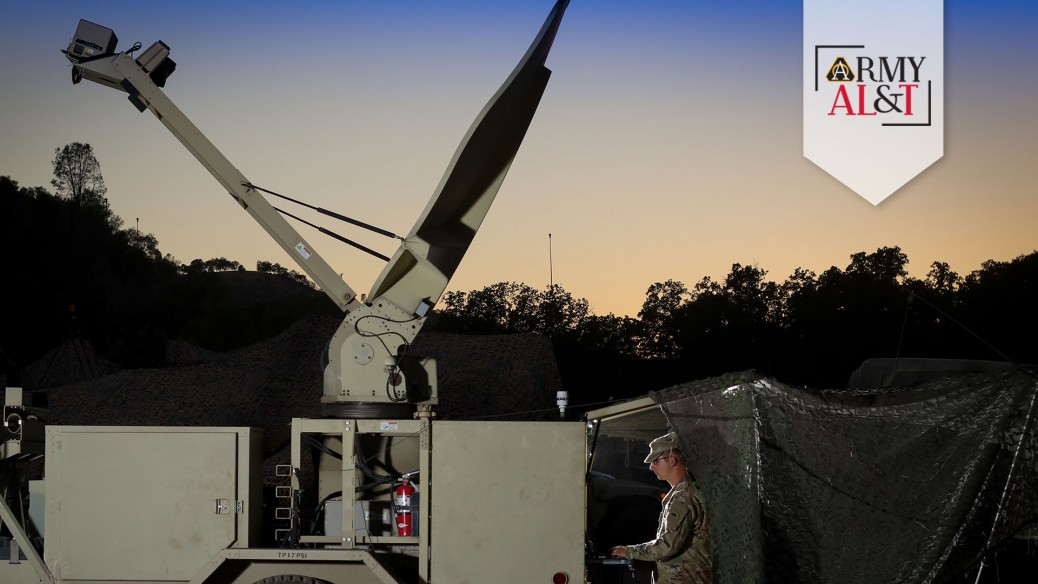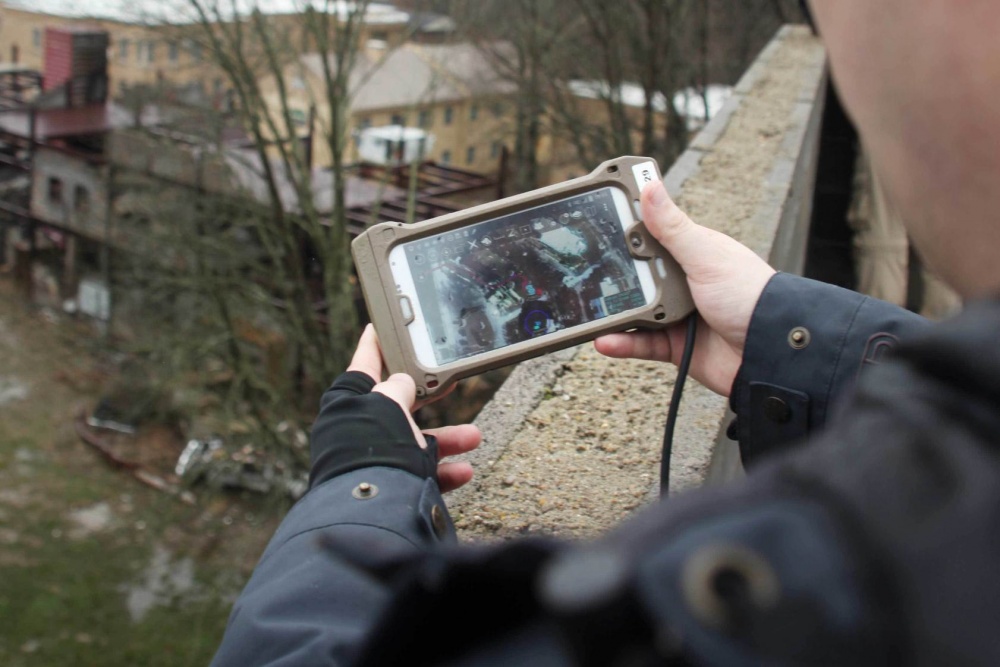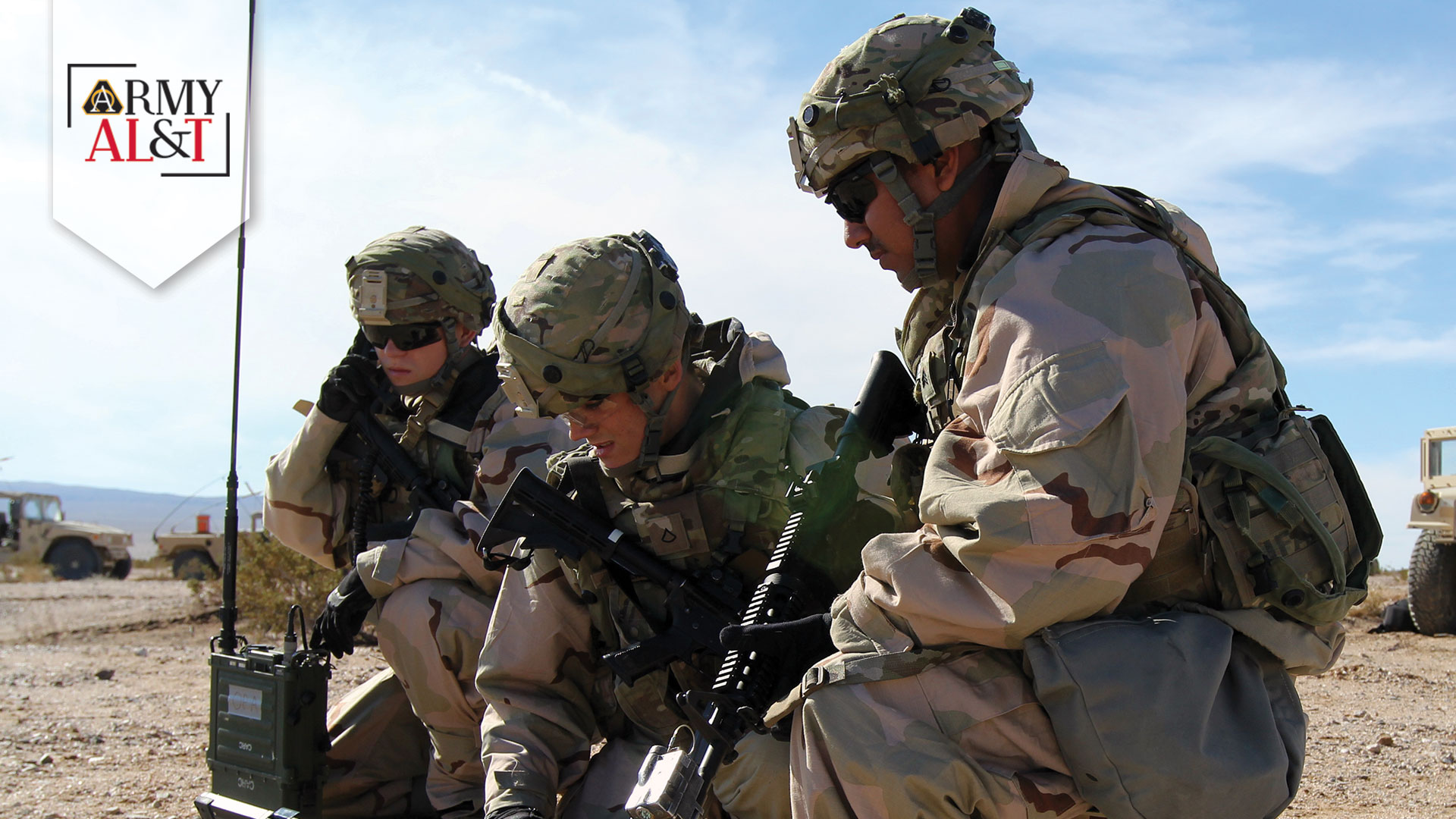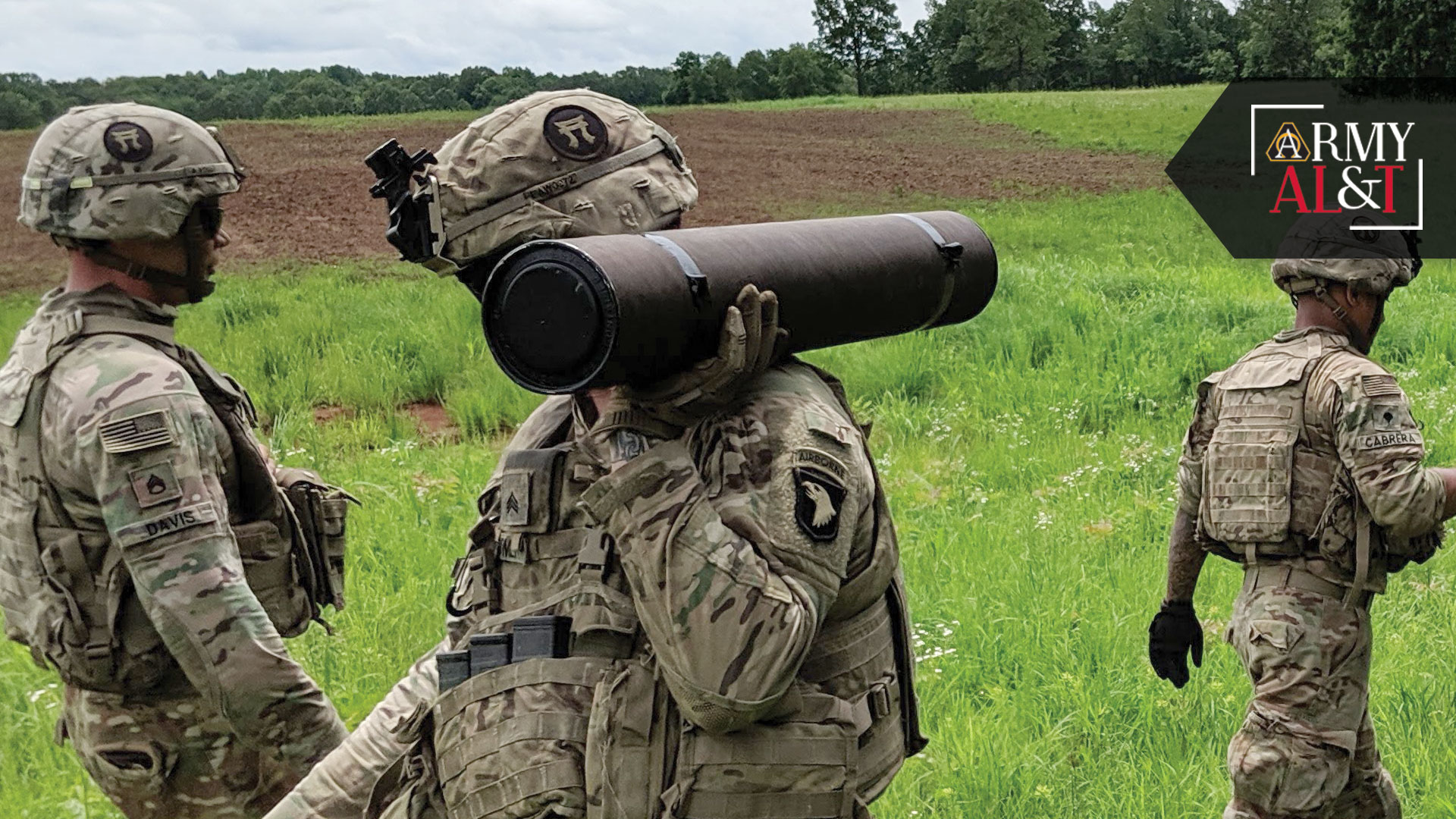To build a network that will last, the Army is planning how to maintain and repair its many components while they’re still being developed.
by Maj. Gen. Randy S. Taylor
In September 2017, the U.S. Army made a startling, but necessary, announcement: It would halt development of the Warfighter Information Network – Tactical (WIN-T), its ambitious network modernization initiative begun in 2007. The voice, video and data transmission system had become too fragile, vulnerable and complex to effectively connect and protect Soldiers in a near-peer adversary fight on the 21st-century battlefield.
The Army needed to change course—fast.
The next month, it announced the creation of the U.S. Army Futures Command and designated the network one of its six modernization priorities. And, in 2018, it stood up the Network Cross-Functional Team, bringing experts across the requirements, development and acquisition communities together to drive what the network would be in the future.
Today the Army is working toward a reliable, resilient and adaptable network that can operate in contested electromagnetic spectrum and cyber environments. The network encompasses two domains: an Integrated Tactical Network focused on battlefield communication and the conduct of war, and an Integrated Enterprise Network focused on hybrid cloud, business and physical infrastructure services and applications.
The Army envisions that, by 2028, the network will be fully unified, sharing common applications, services infrastructure and transport layers. This will help break down data silos and stovepipes, enable interoperability and deliver data at the speed of maneuver to the precise point of need. One of the network’s key requirements is that it can be used as a weapon—and data truly is its ammunition.
CECOM: THE FOUNDATION OF NETWORK SUSTAINMENT
The U.S. Army Communications-Electronics Command (CECOM), a life cycle management command of the U.S. Army Materiel Command, plays a critical role in the success of the Army’s current and future network. CECOM sustains the Army’s vast portfolio of command, control, communications, computers, cyber, intelligence, surveillance and reconnaissance (C5ISR) systems. These hardware and software systems form the backbone of the tactical network, the part of the future network that CECOM is currently responsible to sustain.
To execute that mission, CECOM is heightening its focus on cross-life-cycle engagement, which remains a core fundamental of sustainment even with the introduction of new technologies on the tactical network. The Army has long understood that 55 to 70 percent of a program’s life cycle cost is in the sustainment tail. Given that large cost, effective planning for sustainment must begin when system requirements are being defined. That takes active planning and cooperation with organizations across the Army enterprise.
CECOM works closely with Army Futures Command’s Network Cross-Functional Team; the Office of the Assistant Secretary of the Army for Acquisition, Logistics and Technology; the U.S. Army Training and Doctrine Command; the Army chief information officer/G-6; and others to define sustainment requirements early in the technology life cycle. We also help program executive offices include sustainment language in contracts and create life cycle sustainment plans for fielded systems.
However, the introduction of the tactical network and the return of great power competition bring significant new demands for speed and rigor. In addition to heightening our focus on life cycle engagement with program executive offices and other Army technology organizations, we are challenging the status quo to redesign network sustainment from the ground up.
THE OLD WAY
For much of the last 18 years of combat, the Army operated under the force generation model, which offered generous 180-day periods for whole-unit reconstitution and equipment reset. Under this system, it could take up to six months for CECOM to overhaul and return network equipment, using 26 different sources of repair.
This met the Army’s need for C5ISR sustainment during asymmetric combat operations in Iraq and Afghanistan. But it led to increased costs, long repair turnaround times when units would be without needed equipment, and a general decrease in readiness to fight a near-peer adversary. In a multidomain, unpredictable conflict against a well-equipped enemy, this approach would put Soldiers’ ability to fight and win—and their very lives—in serious jeopardy.
So we’ve taken a hard look at ourselves to drive reform and introduce new capabilities in several key areas—our “new way” of doing business. This new approach to sustainment is nested with the Army’s effort to accelerate technology insertion and close critical gaps by fielding new capability sets on a two-year basis. These technology sets build on one another, are infused with commercial solutions, and are informed by Soldier-led experimentation. This provides flexibility to augment and integrate information technology capabilities as they emerge from industry. Sustainment efforts are adapting to support this approach.
INCREASING SUPPLY AVAILABILITY
CECOM’s No. 1 priority is supply availability—getting the right part to the right place at the right time—and we are making steady progress toward our 100 percent goal. For example, in FY17, supply availability was at 77 percent, but by the end of FY19, it will be 93 percent.
A key part of our supply availability strategy is pricing contracts in advance, based on forecast needs, and moving to longer-term, 10-year contracts for key parts—we will have six such contracts by the end of this fiscal year. These contracts procure from multiple supply sources, and include language for surge production and expedited delivery in case contingencies arise.
Back orders are a sister metric to supply availability and a key indicator of the health of CECOM supply operations. Thanks to similar disciplined reform, we have brought back orders down from more than 8,000 in FY17 to slightly under 3,900 this fiscal year.
IMPLEMENTING REPAIR CYCLE FLOATS
Today, the Army has transitioned away from the force generation model to the sustainable readiness model, which is designed around 90-day prepare modules. Given this change, CECOM is aggressively pursuing repair-cycle floats to get equipment back to units as quickly as possible.
The idea is simple: Maintain pools, or “floats,” of ready-to-issue replacement systems to reduce turnaround times to practically nothing. In FY18, CECOM created the Army’s first-ever float pool with 36 Satellite Transportable Terminals, Forces Command’s highest-priority C5ISR system. That same year, we built floats across six systems totaling 215 units, and in FY19, that has risen to 13 systems totaling 319 units.
REDUCING REPAIR CYCLE TIMES
CECOM is laser-focused on reducing repair cycle times to get network equipment back in the field faster. For example, in the fourth quarter of FY17, it took an average 162 days to repair a Satellite Transportable Terminal at Tobyhanna Army Depot, CECOM’s organic industrial facility in Tobyhanna, Pennsylvania. By the second quarter of FY19, that was down to 40 days.
Tobyhanna Army Depot has driven this improvement with workflow reforms and data-driven decision-making. In fact, its Performance to Promise, a broad, cross-metric measure of depot performance, rose from 49 percent in FY15 to 93 percent in FY19. This also enabled the depot to increase its capacity for major system repairs, which rose from 184 in FY17 to 300 in FY19.
BRINGING DEPOT MAINTENANCE FORWARD
Another pillar of the CECOM sustainment strategy is to move depot-level maintenance and repair capabilities closer to where units are stationed. So in FY18, CECOM stood up Tobyhanna depot forward locations in Korea and Europe. Meanwhile, three depot forward locations in the continental U.S. are coming online this fiscal year.
By providing more immediate access to repair expertise and services, these facilities can help extend C5ISR system life by an average of five to seven years.
SUPPORTING SOFTWARE
Of course, tactical network hardware cannot operate without underlying software, sustainment of which is a core part of CECOM’s mission. Accordingly, CECOM’s Software Engineering Center has heightened its focus on electronic patching, or e-patching, mission command systems that have moved into sustainment. E-patching plugs vulnerabilities in a fast and secure environment, as opposed to manual delivery and installation via CD. This supports the tactical network objectives of increasing network resiliency and reliability by 2028.
Depending on bandwidth requirements and network availability, e-patching is not always viable for certain systems or for units deep in the field. But as much as possible, CECOM is increasingly making it the norm. From e-patching just eight of the 33 systems that were capable of being e-patched in FY17, we anticipate e-patching 24 systems by FY20.
TRANSFORMING CONTRACTING
Transforming contracting is a cornerstone of CECOM’s reform platform. Specifically, CECOM has focused on consolidating software contracts for common functions to find efficiency and save money. We are consolidating 43 such contracts to 34 by the end of this fiscal year.
We are also bringing together sustainment support for enterprise resource planning programs—business management platforms that track and manage financial, inventory and manufacturing data—under a unified contract to be awarded in December 2019. And we are bridging hardware and software sustainment under a major unified field support contract to be awarded by the fourth quarter of FY20.
TAKING OUT ‘INSURANCE’
A brand new concept, data escrow, is another exciting contracting initiative. Under certain circumstances, CECOM may need to secure technical data and intellectual property from manufacturers. However, this could be enormously expensive.
To address the expense, CECOM is experimenting with technical data escrow accounts, set up at the time contracts are signed. These storage accounts give third parties oversight and control of data in a virtual lockbox. They act as insurance policies in case of company bankruptcy, system failure, individual hardware parts becoming unavailable, or other unexpected events. In such cases, CECOM could negotiate to access technical data at a far lower price than it would cost to buy it outright. We have implemented an escrow account in one software contract thus far, and we are laying the groundwork to establish this as common practice.
SUSTAINING COMMERCIAL TECHNOLOGY – 5, 3, 1
For the acquisition and technology community, perhaps the most important network sustainment numbers to remember are five, three and one.
Faced with a mandate to modernize, program executive offices often turn to commercial C5ISR technologies and nonstandard equipment to replace legacy program-of-record systems. The manufacturers warranty these systems, but there is huge variation in warranty durations, conditions and pathways for Soldiers to secure repairs or replacements. To address this challenge, CECOM is borrowing a model the U.S. Army Special Operations Forces Support Activity uses to rapidly exchange non-mission-capable systems that are under warranty.
Five refers to the five-year warranty the Army will pursue for all new commercial off-the-shelf products and nonstandard equipment. Three refers to the Year 3 decision point, when the Army will decide if it will sustain the equipment’s use after the initial warranty period. If yes, it will decide what entity will be responsible for sustainment—in most cases, CECOM, and in others, program executive offices—and establish a lasting supply chain. If no, it will divest the system.
One refers to the central warranty exchange: Tobyhanna Army Depot and its more than 40 forward locations around the world. In the future, Soldiers will be able to hand off any C5ISR commercial off-the-shelf product or nonstandard equipment that’s still under warranty to any Tobyhanna representative, who will send it through the warranty exchange process. The five, three, one concept is still in the planning stages, but we are excited about its potential.
CONCLUSION
This web of connected strategies and initiatives is crucial to sustain the future tactical network in a complex, symmetric combat environment. If we fail to drive innovative reform and plan for tactical network sustainment right now, the risk is threefold.
First, because sustainment is inherent to the network’s design, fielding and operation, the envisioned network of 2028 may not materialize, or it may fail to meet the Army’s warfighting needs. Second, with underequipped units waiting on key C5ISR systems stuck in long repair turnarounds, critical data communications and intelligence would be slowed or prevented from moving where Soldiers need it. And third, the Army would lose opportunities to collect and analyze data and glean insights to make better strategic and business decisions.
Ultimately, we owe it to the Soldiers who depend on C5ISR network equipment and reliable data transmissions to succeed in these efforts at all levels. With their mission and lives at stake, we will not rest in pursuing our mission of empowering the Soldier with sustained C5ISR readiness, anytime, anywhere.
















